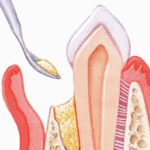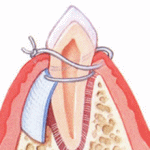
Bone Grafts & Guided Bone Regeneration
Periodontal bone grafting and guided bone regeneration are two surgery procedures often necessary for patients who have suffered extensive jaw bone loss. Both procedures are usually performed as part of periodontal disease treatment in order to restore the lost bone tissue.
When you need Bone Grafting & Guided Bone Regeneration?
Periodontal Bone Grafting is a surgical procedure in which patient’s own bone or artificial material is used to replace the missing bone.
Guided Bone Regeneration (GBR) is a surgical procedure complementary to the bone grafting procedure in which a membrane is placed over the bone graft site to encourage new bone to grow in the area of the ‘bony defect’.
Both procedures are usually needed under the following conditions:
- Periodontal disease treatment – Replacing the bone tissue around teeth that has been lost due to periodontitis and bacterial infection is critical for preventing tooth loss. Not only existing teeth may be lost but the ability of replacing them with dental implants is also decreased if there is extensive loss of jaw bone.
- Placing dental implants – If several teeth have been lost due to periodontal disease or any other cause, they can be replaced by dental implants. For successful placement of implants, adequate width and height of jaw bone must have been restored before the procedure.
- Aesthetic improvement – The loss of jaw bone caused by advanced periodontal disease and tooth loss can seriously affect a person’s appearance. The jaw starts shrinking and the face looks sunken and prematurely aged (facial collapse).
What may cause jaw bone loss?
Jaw bone loss may occur because of:
- Periodontal disease – Periodontitis is an infection of the periodontium characterized by severe bone loss around teeth that in some cases can result in tooth loss if untreated. Periodontitis triggers a response from the body’s immune system. Specialized cells called phagocytes attack and destroy the infected tissues, gums, periodontal ligament and jawbone, in an effort to eliminate the infection.
- Tooth extractions or tooth loss – If a tooth is extracted or lost the body starts to absorb the bone next to the lost tooth’s socket.
- Trauma – cysts – tumor surgery
How does Dental Bone Grafting & Bone regeneration work?
The objective of periodontal bone grafting and regenerative surgery procedures is to try and help the body regenerate that bone tissue around the tooth which has been destroyed. Human bone consists of:
- Organic Matrix (35% of the weight) mainly composed of collagen
- Inorganic Matrix (60-70% of the weight) mainly calcium and smaller quantities of phosphorous, sodium and magnesium.
- Cells such as Osteoblasts, Osteocytes and Osteoclasts.
Every day osteoclasts which are large macrophage cells break down and resorb damaged bone, while osteoblasts replace the lost structure with new bone matrix. Guided bone regeneration aims in stimulating this natural bone creation process in order to replace lost bone tissue. Bone grafts place a framework in the area of missing bone into which osteoblasts start the rebuilding process. Over time the bone graft is remodelled and replaced by new bone.
The Bone Grafting & Guided Bone Regeneration procedures
Before starting a bone grafting and regeneration procedure, all risk factors that have caused the periodontal disease and bone loss must first be controlled. All sources of gum infection must be eliminated by removing diseased or infected tissue with tooth scaling and root planing and maintaining good oral hygiene.
Periodontal Bone grafting procedure

There are several types of bone grafts that can be used:
- Autografts are bone grafts taken from the patient's own body. Autogenous bone grafting is always the first choice for the dentist because autografts give the best results amongst all types of bone grafts. That's because the patient’s own bone marrow contains live cells that help continue bone growth and speed up the healing process. The disadvantage is that a second surgical site is needed where the bone graft will be taken from.
- Allografts are human bone grafts taken from another person and usually provided by bone banks. This type of bone grafts provide an alternative for patients who want to avoid the surgical procedure required for taking the autografts, or when very large blocks of bone are needed.
- Alloplasts make use of synthetic materials for bone formation.
- Xenografts are bone grafts from other species, usually from bovine (cow) or porcein (pig) origin.
If an autograft will be used, a first surgery to harvest the bone graft is performed first. After numbing the area, an incision is made in the gums to expose the jaw bone. The gums are folded back and bone graft material is then placed in the area of the bone loss.
Guided Bone Regeneration procedure

Barrier membranes are used to guide the bone regeneration, with or without the use of bone grafts. After applying the periodontal bone graft material, a membrane made of biocompatible material is placed between the gum and bone in order to stabilize and ‘protect’ the bone graft. Gum tissue grows much faster than bone tissue. The barrier membrane isolates the bone graft, to prevent gum tissue from invading and filling the area disturbing the bone growth.
After the bone graft and the barrier membrane are in place, the gums are placed back over the treated site and stitched into place.
The bone graft material acts as a scaffold on or around which the patient's own bone will grow. After 6-12 months the bone graft will be fused to existing bone or replaced by new bone by the bone regeneration process.
Aftercare of periodontal bone graft
After the bone graft procedure, the dentist will prescribe antibiotics, pain medication and an antibacterial mouthwash. Some pain is expected for about a week after the procedure.
You should avoid putting pressure on the bone graft area while it heals. A soft diet is recommended for some days. Hot foods should also be avoided. The patient must maintain good oral hygiene, but must avoid disturbing the bone graft area.
Cost of dental bone grafting
The average cost of dental bone grafting can range from $250 to $900 for a single tooth area depending on the amount of bone graft needed, the type of bone graft used and the difficulty of each case. In case of autogenous grafts taken from the hip bone, the cost of bone graft can raise well over $2,500 due to the additional costs for hospitalisation, orthopaedic surgeon, anaesthesiologist and medications.
The use of Growth Factor Enhanced Grafts in order to accelerate the bone formation can reduce the time of treatment and the treatment success rate but it will further increase the cost of the dental bone grafting procedure.

